数据结构-并查集
简介
并查集(Disjoint-Set)是一种可以动态维护若干个不重叠的集合,并支持合并与查询两种操作的一种数据结构。
就是维护多个集合之间的关系,集合的合并和查询定位(哪个元素属于哪些集合等查询操作),所以并查集主要包括两种操作:
- 合并(Union):合并两个集合;
- 查询(Find):查询元素属于哪些集合。
由上面的概念,我们可以知道并查集主要解决以下几个个问题:
- 合并两个或多个集合;
- 判断某一个元素或者多个元素是否属于某个集合
分析
慢union,快find
我们可以用数组来表示数据结构(并查集表示的是多个集合之间的关系,使用map不能直观的描述多个集合的关系),数组的下标代表元素,存储的内容代表所在的集合,如下:

此时假如我们需要将元素2合并到元素1所在集合,则直接使arr[2]=arr[1]就行了

假如我们要将1集合加入到3集合,也就是元素1和元素2加入到3的集合中,则需要将元素1和元素2所在的集合做更改,arr[1]=3,arr[2]=3,合并的时间复杂度为O(n)

这时判断元素1和元素2是否在同一个集合只需要判断数组内值是否相等即可arr[1]==arr[2],相等则说明属于同一个集合,时间复杂度为O(1)
示例代码如下(慢union,快):
package com.example.demo;
public class Test {
private static int[] arr = new int[]{0,1,2,3,4,5,6,7};
public static void main(String[] args) throws Exception {
System.out.println("元素所在集合初始:" );
arrToString(arr);
System.out.println("将元素2合并到元素1所在集合");
union(2,1);
arrToString(arr);
System.out.println("将元素1、2合并到3所在集合");
union(1,3);
arrToString(arr);
}
/**
* 查看元素属于哪个集合
* 时间复杂度为 O(1)
* @param index
* @return
*/
public static int find(int index){
return arr[index];
}
/**
* 判断两个元素是否属于同一个集合
* @param first
* @param second
* @return
*/
public static boolean isTogether(int first, int second){
return find(first) == find(second);
}
/**
* 时间复杂度为 O(n)
* 将first元素所在集合合并到second元素所在集合
* @param first
* @param second
*/
public static void union(int first, int second){
int m1 = find(first);
int m2 = find(second);
for(int i = 0; i < arr.length;i++){
if(arr[i] == m1 ){
arr[i] = m2;
}
}
}
public static void arrToString(int[] arr){
if(null == arr || arr.length <= 0){
return;
}
System.out.print("数组元素:");
for(int i = 0 ; i < arr.length ; i ++){
System.out.print(i + " " );
}
System.out.println("");
System.out.print("所在集合:");
for(int c : arr){
System.out.print(c + " ");
}
System.out.println("");
}
}
输出:
元素所在集合初始:
数组元素:0 1 2 3 4 5 6 7
所在集合:0 1 2 3 4 5 6 7
将元素2合并到元素1所在集合
数组元素:0 1 2 3 4 5 6 7
所在集合:0 1 1 3 4 5 6 7
将元素1、2合并到3所在集合
数组元素:0 1 2 3 4 5 6 7
所在集合:0 3 3 3 4 5 6 7
上面的方法union时间复杂度是O(n),每次合并都需要把需要合并的集合遍历一遍,当集合内数据很大时肯定是不行的,我们需要对union进行优化
快union,慢find
我们将上面的关系转化为树形结构,改成树形结构时我们需要对数组进行小调整,数组下标依然表示元素,数组内容需要变为父集合。
上面我们将2加入1,则元素2的父集合就是1所在的集合,1加入3则元素1的父集合就是3所在的集合,稍做调整后的数组结为arr[2]=arr[1],arr[1]=arr[3],如图:

树形结构如下图:
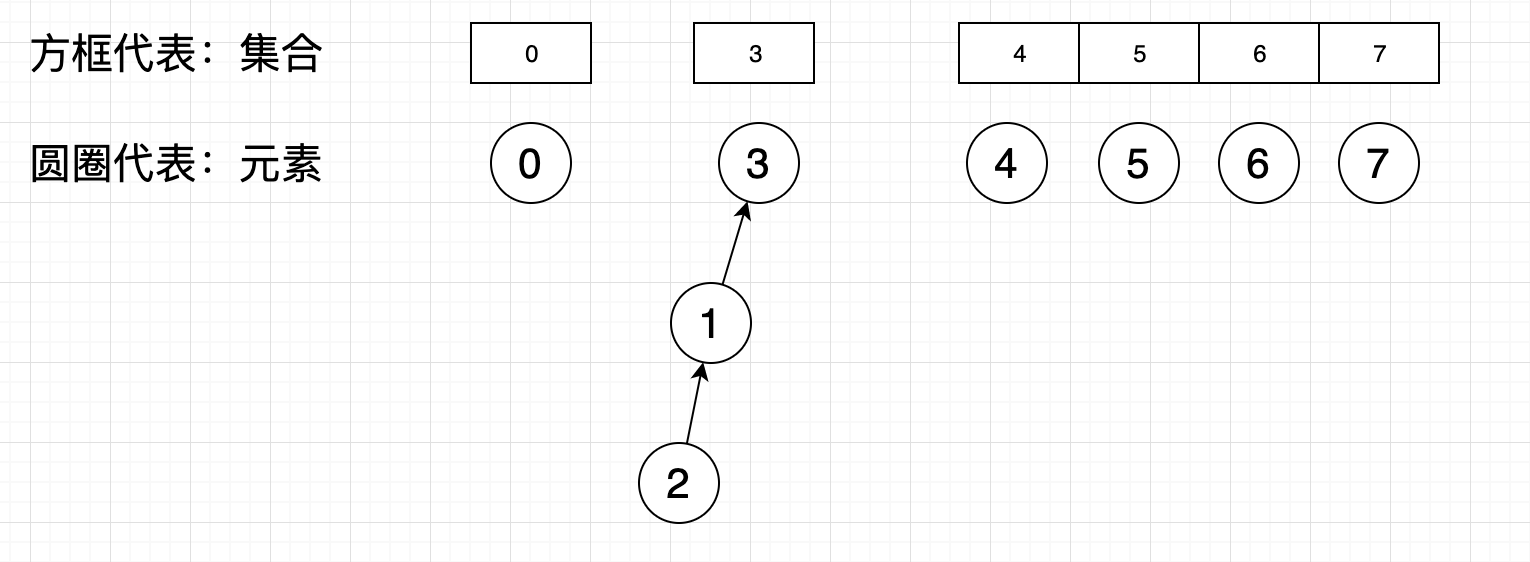
这个时候假如我们将3集合合并到4集合,其实只需要把领头的元素3加入到4集合,元素1,2,3的关系保持不变就可以了,只需要操作一步就完成了合并操作。这个时候数据结构就从数组转变成了树形结构,成功的将union时间复杂度变为了O(1)
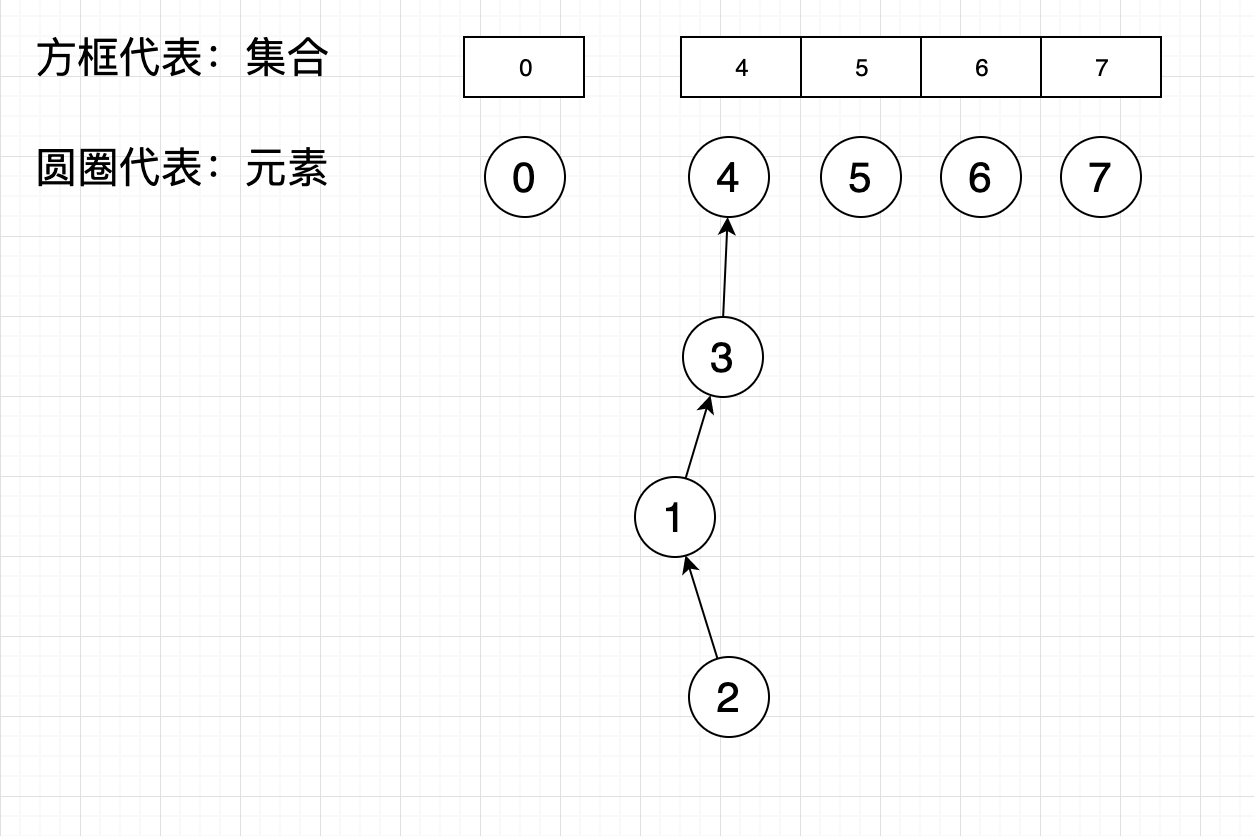
再来看find(1),需要找到顶部元素所在集合(也就是元素4所在集合)即可,时间复杂度取决于树的深度
示例代码:
package com.example.demo;
public class Test2 {
private static int[] arr = new int[]{0,3,1,3,4,5,6,7};
public static void main(String[] args) throws Exception {
System.out.println("元素所在集合初始:");
arrToString(arr);
System.out.println("将元素3所在集合合并到元素4所在集合");
union(3, 4);
arrToString(arr);
}
/**
* 查看元素属于哪个集合
* 时间复杂度为 O(1)
* @param index
* @return
*/
public static int find(int index){
// 判断自己是不是顶部节点 没有父集合就是顶部元素
while(index != arr[index]){
//如果不是顶部元素 则往上查找 知道找到顶部元素为止
//顶部元素所在的集合就是该元素所在的集合
index = arr[index];
}
return index;
}
/**
* 判断两个元素是否属于同一个集合
* @param first
* @param second
* @return
*/
public static boolean isTogether(int first, int second){
return find(first) == find(second);
}
/**
* 时间复杂度为 O(n)
* 将first元素所在集合合并到second元素所在集合
* @param first
* @param second
*/
public static void union(int first, int second){
int firstRoot = find(first);
int secondRoot = find(second);
// 如果所属集合相等则不操作
if(firstRoot == secondRoot){
return ;
}
// 否则将first元素所在集合的顶部元素所在的父集合指向元素second顶部元素所在的集合,则完成了合并
arr[firstRoot] = secondRoot;
}
public static void arrToString(int[] arr){
if(null == arr || arr.length <= 0){
return;
}
System.out.print("数组元素:");
for(int i = 0 ; i < arr.length ; i ++){
System.out.print(i + " " );
}
System.out.println("");
System.out.print("所在集合:");
for(int c : arr){
System.out.print(c + " ");
}
System.out.println("");
}
}
输出:
元素所在集合初始:
数组元素:0 1 2 3 4 5 6 7
所在集合:0 3 1 3 4 5 6 7
将元素3所在集合合并到元素4所在集合
数组元素:0 1 2 3 4 5 6 7
所在集合:0 3 1 4 4 5 6 7
快速union,快速find,基于重量
上面的例子中我们要找到2所在的集合需要把整个集合都遍历一遍,这是因为每次合并时都是往父一级追加,形成了线性链表,上面的优化导致了find方法时间复杂度为集合深度。为了再次优化find方法,我们需要优化树结构的生成规则。既然两个元素合并到一个元素,以上面的例子举例,元素3合并到元素4和元素4合并到元素3其实是一个效果,但是显然元素4合并到元素3更为合理。也就是谁元素多谁为主,元素少的集合合并到元素多的集合中,这样就能降低树的深度提高find效率了
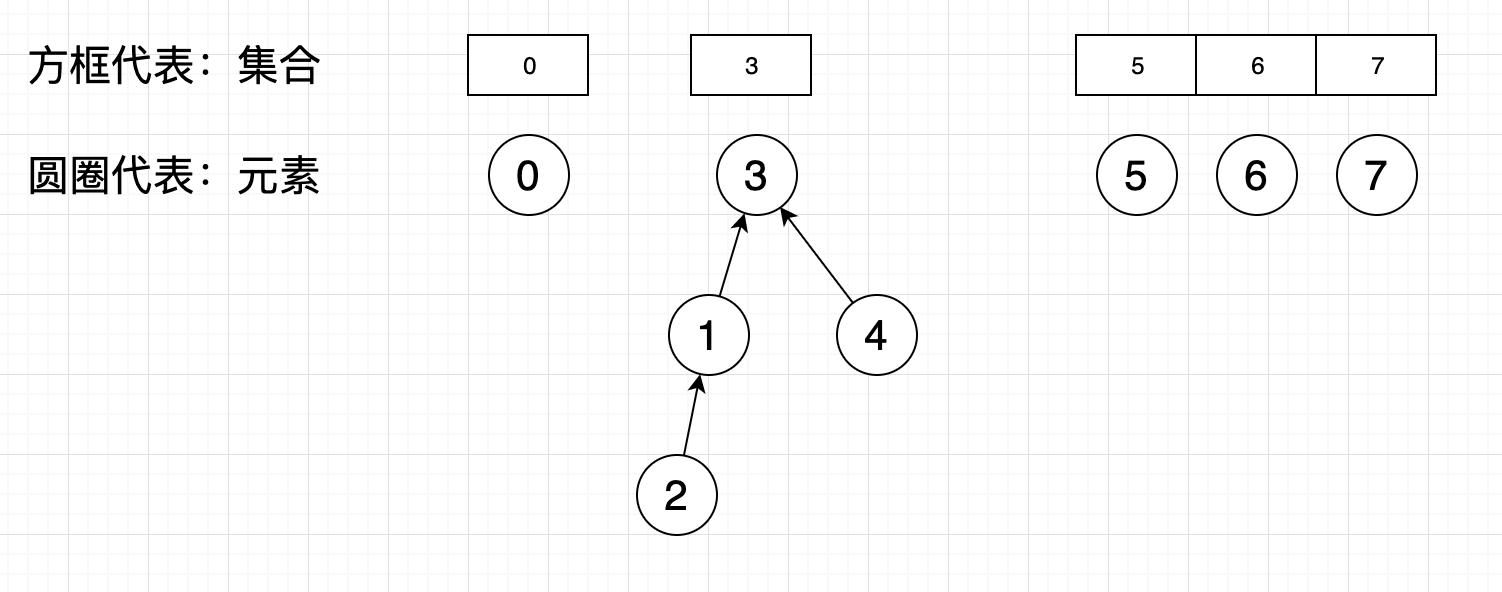
示例代码:
package com.example.demo;
public class Test3 {
private static int[] arr = new int[]{0,3,1,3,4,5,6,7};
private static int[] weight = new int[]{1,1,0,2,1,1,1,1};
public static void main(String[] args) throws Exception {
System.out.println("元素所在集合初始:");
arrToString(arr);
System.out.println("将元素3所在集合和元素4所在集合合并");
union(3, 4);
arrToString(arr);
}
/**
* 查看元素属于哪个集合
* 时间复杂度为 O(1)
* @param index
* @return
*/
public static int find(int index){
// 判断自己是不是顶部节点 没有父集合就是顶部元素
while(index != arr[index]){
//如果不是顶部元素 则往上查找 知道找到顶部元素为止
//顶部元素所在的集合就是该元素所在的集合
index = arr[index];
}
return index;
}
/**
* 判断两个元素是否属于同一个集合
* @param first
* @param second
* @return
*/
public static boolean isTogether(int first, int second){
return find(first) == find(second);
}
/**
* 时间复杂度为 O(n)
* 将first元素所在集合合并到second元素所在集合
* @param first
* @param second
*/
public static void union(int first, int second){
int firstRoot = find(first);
int secondRoot = find(second);
// 如果所属集合相等则不操作
if(firstRoot == secondRoot){
return ;
}
// 取出所在集合元素个数
int fweight = weight[firstRoot];
int sweight = weight[secondRoot];
if(fweight < sweight){
//若second所在集合元素个数大于first所在集合元素个数
// 则将first元素加入second元素所在集合
arr[firstRoot] = secondRoot;
weight[secondRoot] = sweight + fweight ;
}else{
// 于上面相反
arr[secondRoot] = firstRoot;
weight[firstRoot] = fweight + sweight;
}
}
public static void arrToString(int[] arr){
if(null == arr || arr.length <= 0){
return;
}
System.out.print("数组元素:");
for(int i = 0 ; i < arr.length ; i ++){
System.out.print(i + " " );
}
System.out.println("");
System.out.print("所在集合:");
for(int c : arr){
System.out.print(c + " ");
}
System.out.println("");
System.out.print("集合重量:");
for(int c : weight){
System.out.print(c + " ");
}
System.out.println("");
}
}
元素所在集合初始:
数组元素:0 1 2 3 4 5 6 7
所在集合:0 3 1 3 4 5 6 7
集合高度:1 1 0 2 1 1 1 1
将元素3所在集合合并到元素4所在集合
数组元素:0 1 2 3 4 5 6 7
所在集合:0 3 1 3 3 5 6 7
集合重量:1 1 0 3 1 1 1 1
观察上面输出可以看到元素4加入了集合3
快速union,快速find,基于高度(基于秩)
对于上述改进方法,只是单纯的判断集合内元素的个数大小来决定如何合并集合,如果数据结构是如下图时:
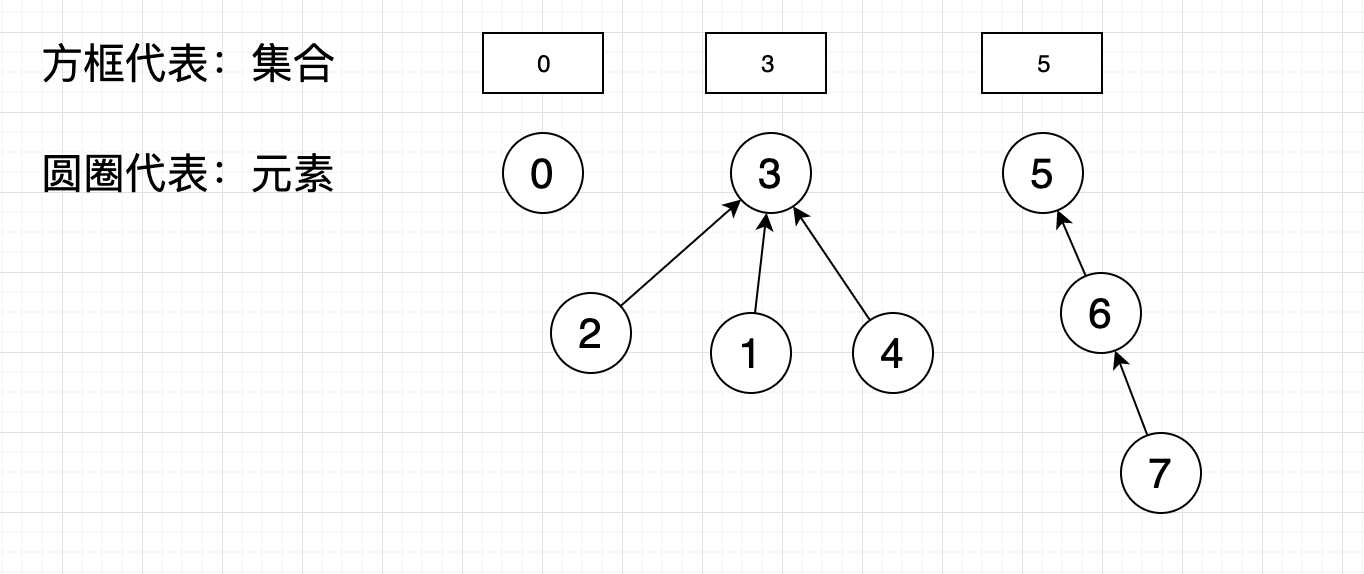
假如按照元素个数谁大合并到谁那则会出现下面的情况

集合5加入了集合3,树的高度变为了4,极端情况下find的时间复杂度会无限接近o(n)(无限接近线性链表的结构)。假如我们按照树的高度来判断合并到哪个集合,上述情况合并会得到:
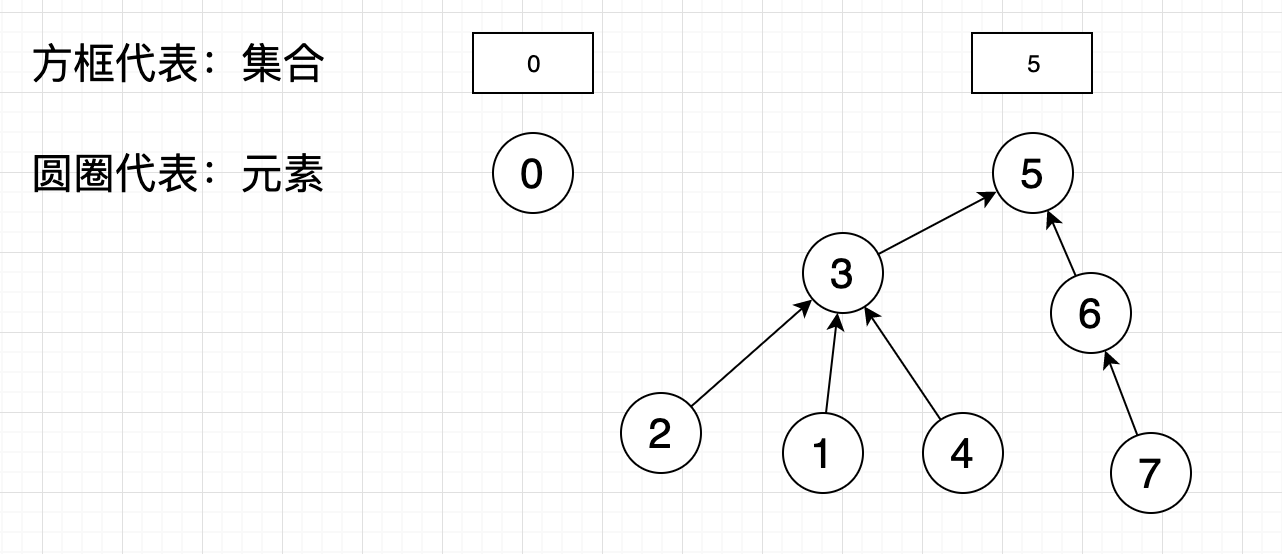
示例代码:
package com.example.demo;
public class Test4 {
private static int[] arr = new int[]{0,3,3,3,3,5,5,6};
private static int[] height = new int[]{1,1,1,2,1,3,2,1};
public static void main(String[] args) throws Exception {
System.out.println("元素所在集合初始:");
arrToString(arr);
System.out.println("将元素3所在集合和元素5所在集合合并");
union(3, 5);
arrToString(arr);
}
/**
* 查看元素属于哪个集合
* 时间复杂度为 O(1)
* @param index
* @return
*/
public static int find(int index){
// 判断自己是不是顶部节点 没有父集合就是顶部元素
while(index != arr[index]){
//如果不是顶部元素 则往上查找 知道找到顶部元素为止
//顶部元素所在的集合就是该元素所在的集合
index = arr[index];
}
return index;
}
/**
* 判断两个元素是否属于同一个集合
* @param first
* @param second
* @return
*/
public static boolean isTogether(int first, int second){
return find(first) == find(second);
}
/**
* 时间复杂度为 O(n)
* 将first元素所在集合合并到second元素所在集合
* @param first
* @param second
*/
public static void union(int first, int second){
int firstRoot = find(first);
int secondRoot = find(second);
// 如果所属集合相等则不操作
if(firstRoot == secondRoot){
return ;
}
// 取出所在集合元素个数
int fheight = height[firstRoot];
int sheight = height[secondRoot];
if(fheight < sheight){
//若second所在集合高度大于first所在集合高度
// 则将first元素加入second元素所在集合
// 高度取决于最高的集合 所以最大高度并不会改变
arr[firstRoot] = secondRoot;
}else if(fheight == sheight){
//若second所在集合高度和first所在集合高度 相等
// 则将first元素加入second元素所在集合
// 高度+1
arr[firstRoot] = secondRoot;
height[secondRoot] = sheight + 1;
}else{
//若second所在集合高度小于first所在集合高度
// 则将second元素加入first元素所在集合
// 高度不变
arr[secondRoot] = firstRoot;
}
}
public static void arrToString(int[] arr){
if(null == arr || arr.length <= 0){
return;
}
System.out.print("数组元素:");
for(int i = 0 ; i < arr.length ; i ++){
System.out.print(i + " " );
}
System.out.println("");
System.out.print("所在集合:");
for(int c : arr){
System.out.print(c + " ");
}
System.out.println("");
System.out.print("集合高度:");
for(int c : height){
System.out.print(c + " ");
}
System.out.println("");
}
}
输出:
元素所在集合初始:
数组元素:0 1 2 3 4 5 6 7
所在集合:0 3 3 3 3 5 5 6
集合高度:1 1 1 2 1 3 2 1
将元素3所在集合和元素5所在集合合并
数组元素:0 1 2 3 4 5 6 7
所在集合:0 3 3 5 3 5 5 6
集合高度:1 1 1 2 1 3 2 1
最大高度还是3没有变化
路径压缩
针对基于重量的优化,我们可以将叶子节点直接指向父元素的父元素所在集合,这样也能压缩树的高度,提高find性能。这种方法实际上没有改变树的结构,只是直接越级查找了
示例代码:
package com.example.demo;
public class Test32 {
private static int[] arr = new int[]{0,3,1,3,4,5,6,7};
private static int[] weight = new int[]{1,1,0,2,1,1,1,1};
public static void main(String[] args) throws Exception {
System.out.println("元素所在集合初始:");
arrToString(arr);
System.out.println("将元素3所在集合和元素4所在集合合并");
union(3, 4);
arrToString(arr);
}
/**
* 查看元素属于哪个集合
* 时间复杂度为 O(1)
* @param index
* @return
*/
public static int find(int index){
// 判断自己是不是顶部节点 没有父集合就是顶部元素
while(index != arr[index]){
//如果不是顶部元素 则往上查找 知道找到顶部元素为止
// 这里查找采用路径压缩法,越过一级往上查找
index = arr[arr[index]];
}
return index;
}
/**
* 判断两个元素是否属于同一个集合
* @param first
* @param second
* @return
*/
public static boolean isTogether(int first, int second){
return find(first) == find(second);
}
/**
* 时间复杂度为 O(n)
* 将first元素所在集合合并到second元素所在集合
* @param first
* @param second
*/
public static void union(int first, int second){
int firstRoot = find(first);
int secondRoot = find(second);
// 如果所属集合相等则不操作
if(firstRoot == secondRoot){
return ;
}
// 取出所在集合元素个数
int fweight = weight[firstRoot];
int sweight = weight[secondRoot];
if(fweight < sweight){
//若second所在集合元素个数大于first所在集合元素个数
// 则将first元素加入second元素所在集合
arr[firstRoot] = secondRoot;
weight[secondRoot] = sweight + fweight;
}else{
// 于上面相反
arr[secondRoot] = firstRoot;
weight[firstRoot] = fweight + sweight;
}
}
public static void arrToString(int[] arr){
if(null == arr || arr.length <= 0){
return;
}
System.out.print("数组元素:");
for(int i = 0 ; i < arr.length ; i ++){
System.out.print(i + " " );
}
System.out.println("");
System.out.print("所在集合:");
for(int c : arr){
System.out.print(c + " ");
}
System.out.println("");
System.out.print("集合重量:");
for(int c : weight){
System.out.print(c + " ");
}
System.out.println("");
}
}
输出:
元素所在集合初始:
数组元素:0 1 2 3 4 5 6 7
所在集合:0 3 1 3 4 5 6 7
集合重量:1 1 0 2 1 1 1 1
将元素3所在集合和元素4所在集合合并
数组元素:0 1 2 3 4 5 6 7
所在集合:0 3 1 3 3 5 6 7
集合重量:1 1 0 3 1 1 1 1
应用场景:
并查集在很多场景都可以使用,比如地图寻址,im的群查找合并,数据统计等
例如:https://blog.csdn.net/jert159/java/article/details/38617095



